#nao bustamante
Explore tagged Tumblr posts
Text



Debuting Grave Gallery on a burial plot at Hollywood Forever, artist Nao Bustamante sees a synergy between the cemetery as a site of community.
2 notes
·
View notes
Text
New Podcast Unbound - On Performance and Video Art
#skip to english Begleiten Sie uns auf dieser Audio-Reise, moderiert von den Kurator*innen der Ausstellung, Line Ajan und Lisa Long, um die faszinierenden Theorien, Geschichten und Kunstwerke zu entdecken, die für die Geschichte der Performance- und Videokunst von Bedeutung sind. In Fortführung der Themen der Ausstellung bietet der Podcast einen umfassenden Blick auf die Zusammenhänge zwischen…
#Amelia Jones#art#berlin#Düsseldorf#Greg de Cuir Jr.#Howardena Pindell#Julia Stoschek Foundation#Kunst#Line Ajan#Lisa Long#mandla#Marilena Borriello#Nao Bustamante#Peggy Phelan#peter campus#Salim Bayri#Stanya Kahn#Tarek Lakhrissi#Ulysses Jenkins#UNBOUND#Uri McMillan
0 notes
Photo

LA’s Hottest New Gallery Is in a Cemetery
0 notes
Text



#trip to the art museum :)#pieces r from top to bottom On the other side of everything by Calida Rawles#Indigurrito by Nao Bustamante#Samurai Tree by Gabriel Orozco#and Humanscapes 69(Circle of Decency) by Mel Casas
0 notes
Photo
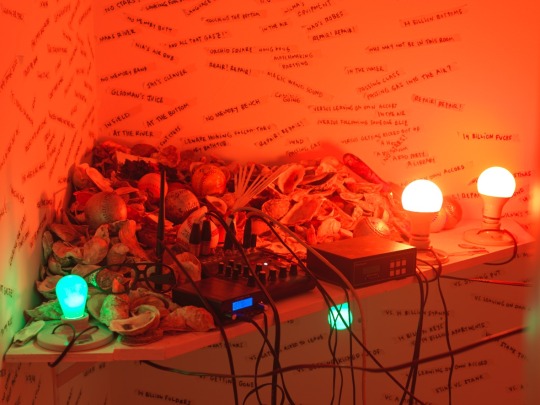
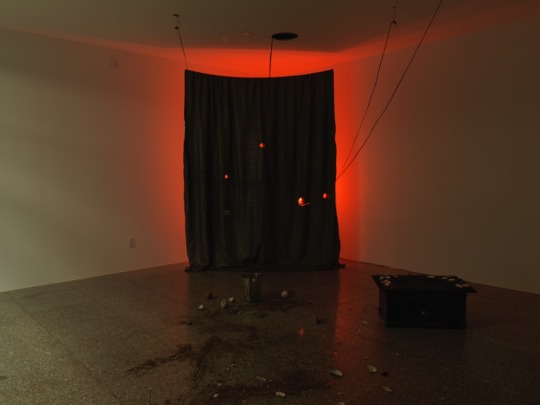

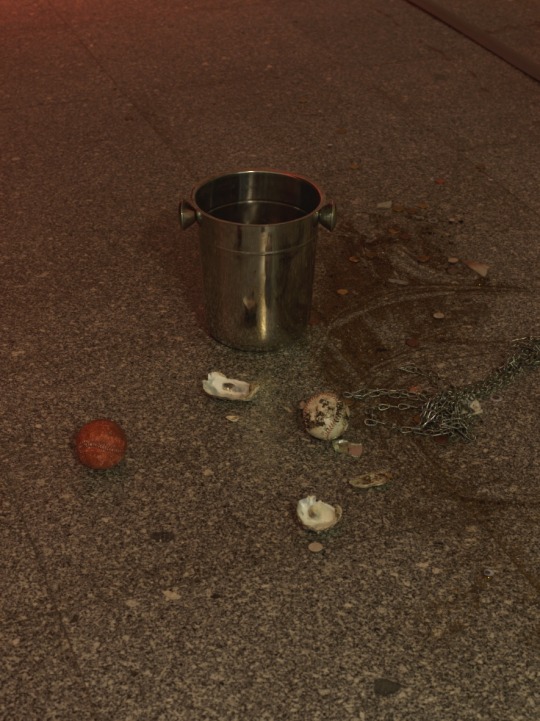
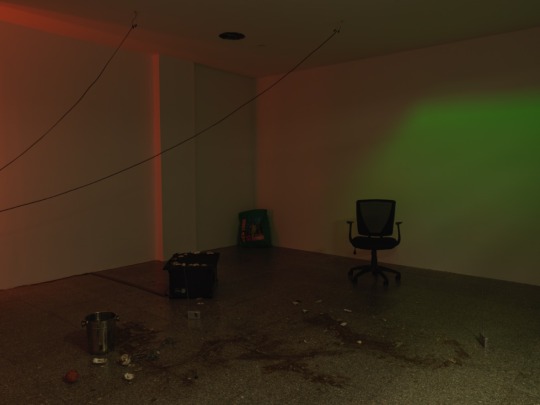
“Muck Studies Dept: Looking for Stars Out of What Stinks”
Geo Wyex
OCD Chinatown
Curated by Tavia Nyong’o
Courtesy of Nao Bustamante
NY, NY
Sept 11 - Oct 31 2022
When I think about lighting in my shows, I try to animate what is already not being lit by drawing on the lack of light, thinking less in terms of “shadow” and more in terms of a not having, seeking either a dusky quality of light diffusion, an adjacency to focus, or an altering of color. What it means to be next to light, rather than in it, or as its shadow. Like the moment right before a performer steps into the light on a stage, or the moment after. That feeling.
2 notes
·
View notes
Photo

HARD RETURN!: Kate Gilmore (A '12) co-curated with Jonah Westerman
Artists Include: Brendan Fernandes, Alix Pearlstein (F '04), Daniel Bozhkov (A '90, F '11, '16) Nao Bustamante (A '99), Amber Hawk Swanson (A '99), Emily Coates, Autumn Knight (A '16), Patty Chang (A '03) with Astrida and Aleksija Neimanis, Jesus Benavente (A '12) The Neuberger Museum of Art 735 Anderson Hill Road, Purchase, NY 10577 February 1—May 7, 2023
1 note
·
View note
Link
0 notes
Photo

Nao Bustamante, Silver & Gold, 2010
4 notes
·
View notes
Video
youtube
Hott MT- Tranceforming
Things to do in Los Angeles this weekend (11/2-11/5/17)-
Thursday
MOCA Grand Avenue is having a free (but RSVP) music night with DJDS, DJ Frosty, Wyldeflower and Deejay.fm
At The Geffen Contemporary at MOCA, architect Liam Young will be discussing artist Adrián Villar Rojas and his current MOCA exhibition (free)
Daniel Johnston is playing at the Orpheum Theatre
Artist Nao Bustamante will be discussing certain works on a walk-through Hammer Museum's Radical Women exhibit. There will also be music for Latinas Out Loud:Ayer Es Hoy with Sotomayor, Sin Color and Chulita Vinyl Club performing (free)
Ukrainian band DakhaBrakha are playing at The Echo with JJUUJJUU
Friday
Metro Art is screening Agnés Varda's film Mur Murs at Union Station as part of its series of documentaries about Los Angeles (free)
A Giant Dog are playing with Wild Wing and Chief White Lightning at the Bootleg Theater
The Drums are playing at the Fonda Theatre with Methyl Ethel (also Thursday, and Saturday with Slow Hollows)
Ted Leo and the Pharmacists are playing at the Teragram Ballroom with Ian Sweet opening
Yaeji is having an EP release party at El Cid
Saturday
Grand Ave Arts All Access has free admission and events planned all day at many of the cultural institutions located on Grand Ave including MOCA and the LA Opera at the Dorothy Chandler Pavilion
Grand Park still has its altars for Día de los Muertos up until Sunday
Wand are playing at the Hi Hat with Lars Finberg and Olga opening
Self Help Graphics are having a Día De Los Muertos Celebration
"Weird Al "Yankovic, John Stamos, Elle King and more will be singing iconic songs from the original Willy Wonka and the Chocolate Factory film as it plays on the Hollywood Bowl movie screen
Dopium.LA is a one night event in Chinatown where artists will create "original pieces to bring the plaza (aka the "Canvas") to life through mixed media, from sculptures, paintings and photographs to video and light projections" plus music, food and drink (free but register)
Ministry are playing at the Hollywood Palladium with Death Grips opening
Saturday and Sunday
ComplexCon's two day event has performers that include N.E.R.D., A-Trak, A$AP Ferg, M.I.A., Young Thug, Gucci Mane, D.J.Khaled; as well as panels, an art exhibition, shopping and more
Sunday
Hott MT are opening for Reptaliens and Fawns of Love at the Echoplex
Artist Ellen Gallagher will be in conversation with LACMA curator Christine Y. Kim at Hauser & Wirth, where Gallagher's first solo exhibition in Los Angeles is currently on view (free but register)
Yelle is playing at Resident with Lewis OfMan opening
The Rock N Roll Flea Market returns to The Regent Theater (free)
#hott mt#moca#dopium la#ellen gallagher#yelle#lewis ofman#complexcon#ministry#death grips#ted leo and the pharmacists#self help graphics#wand#grand ave arts all access#yaeji#hammer museum#the drums#agnes varda#dakhabrakha#a giant dog#nao bustamante#hauser and wirth#daniel johnston#djds#liam young#adrian villar rojas#music#playlist#los angeles events#los angeles
1 note
·
View note
Text
To Become with Others
A reflection on the importance of intra-action in my performance practice.
I am sitting.
I am sitting in a rehearsal space.
It’s a big space.
And it’s mostly empty.
I could…
I could…
I could do a lot of things,
here
in this big open space.
I stand up.
I walk across the room.
I try moving my body a bit.
It feels good but it’s not what I’m looking for.
I try filling the void with my voice, which feels good too, but…
But
The stakes are low.
I try writing things on big pieces of paper. I hope it will fill the vastness around me, but...
But all it does is echo the expanse of my mind. So I try moving these big pieces of paper around, my generous handwriting seems flimsy against their broadness. And sitting somewhere in all this space is the thing I’ve tried so hard to bat away, with my body or with my voice or with my writing. Thinking if I fill it, it won’t have the space to exist.
“But if I were a real artist I would know what to do."
What am I supposed to do here?
How can I best use this space for my research?
What can I uncover?
Here.
Alone.
Who am I without anyone else?
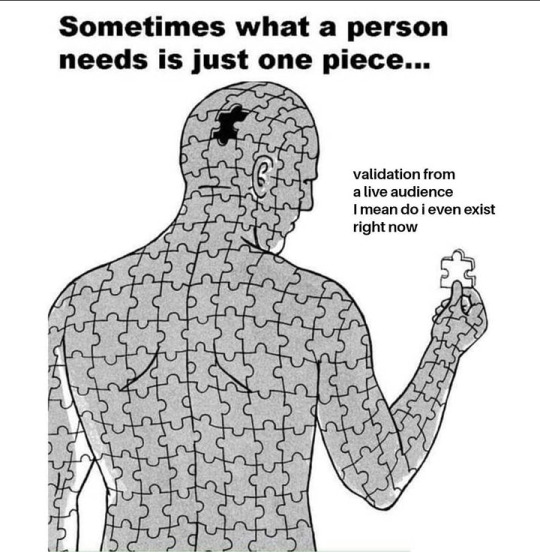
via Somatic_based_content_only on Instagram. 19.04.21
This scenario repeated itself during a workshop with Dagmar Slagmolen, director of the Amsterdam-based music theatre company, Via Berlin. Over the past few months my research has focused on vulnerability and its role in audience participation. My aim is to create a method for accessing and utilizing my own emotional vulnerability to better connect with my audience in order to enhance and expand the participatory experience. In our initial meetings, Dagmar was very excited about this project, particularly my interest in the links between shame and vulnerability. The piece I am creating in order to explore some of these techniques, focuses around my personal sexual history and hopes to buff out some of the shame which is so deeply ingrained in the patriarchal narratives surrounding sexuality in western society. In the days prior to the physical workshop, I discussed my work with Dagmar and the three other workshop participants, which helped me condense and clarify my research so far. I was then given the task of continuing to think about and experiment with vulnerability during the workshop.. Therefore, after a brief talk with Dagmar upon arriving in the studio, I was left with, none other than….. space and time to experiment.


Spaces which I had time to experiment in
Sitting in this studio, I became increasingly aware of a considerable obstacle. Explore vulnerability with who? Myself? Can one even be vulnerable with one’s self? Vulnerability is an act of revealing, an act of (emotional) exposure (Brown 2012). I find this an impossibility considering the omnipresence of the self. At least for me personally, the idea of exposing my self to myself seems nonsensical, as my emotional vulnerabilities exist in relation to others. This notion of impossibility seems to parallel the more ambiguous feeling that I described in the introduction, which creeps in whenever I undergo a solo studio practice in order to create work. The work I make is not only the presentation of a skill or story or technique, but the intra-action of space, time, set parameters and most importantly, other people. While I may use studio time to learn or refine certain physical techniques, this is usually a small element of my practice. Just as I cannot experiment or rehearse my vulnerability alone due to the fact that the very notion of my vulnerability is conditional to the presence of others, so is it impossible for me to experiment or rehearse a performance which is reliant on inter and intra-actions with people around me.

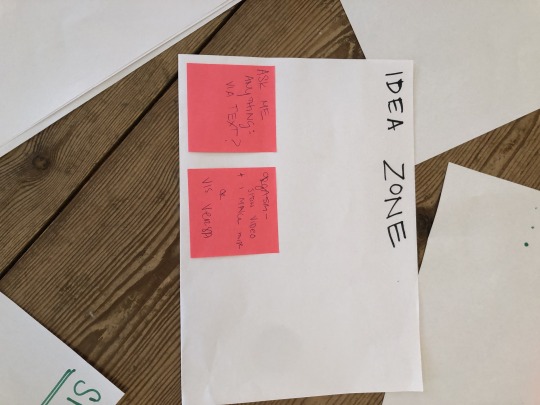
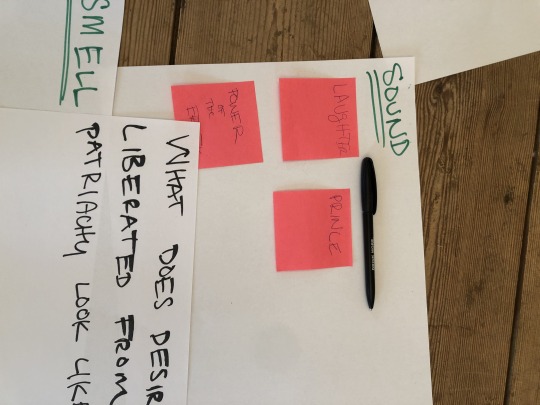

Pieces of paper, large and small
If all the world’s a stage, then when and where do we rehearse? When and where do we experiment? According to performance scholar Richard Schechner, the extended childhood particular to humans is a rehearsal, where we learn the behaviours which we ‘restore’ each day in our performance as adults (2013, 29). However, as restored behaviour may be combined and adjusted in a multitude of ways, and as our co-performers, sets and scenery are invariably interchanged, one’s performances of restored behaviour are thus in eternal flux. The performance of everyday interactions is a constant improvisation structured through certain social parameters. Each experience becomes the rehearsal for the next. It is an act of becoming, an intra-action of the players, the space, the audience etc. Scholar and physicist Karan Barad defines intra-action as “a mutual constitution of entangled agencies” (2007, 33). As I understand intra-action, it negates the idea that anything can be independent from anything else. If I think about it in the context of interactions with others, I understand that my presence and actions do not come from a self that is independent of those around me, but instead materializes through my relationships with others. Moreover, because of the multiplicitous constellations of people, places and things that come into contact throughout daily life, this diffracts into exponential infinity.
As much of my practice relies on such intra-action between myself and the other persons in the performance space, I must then question the where, how and why’s of rehearsal in my practice. Improvisation has always been wildly fulfilling to me, and even more so when I have an audience. This overused saying of ‘dance like no one's watching’ has never made sense to me. It is the eyes of others that grant me the ability to take the risks that make for an exhilarating performance. It is here where I get an embodied sense of intra-action between the audience, and myself where our relationship invokes a disassembly of any and all facades of self.

Some reflections on my relationship to improvisation as a 14-year-old
As I better understand this relationship, it also becomes clear as to why cabaret has remained at the heart of my practice. While I may wear the same costume and perform to the same music for any given act, the stage which I step on is always different, anywhere from a small piece of cleared floor with an audience member given a light with which to illuminate it, to a circus tent in the middle of a music festival as swarms of drunk people wander in after a headliner rock band. I have given myself the same task and the same tools in each however, I must remain nimble and responsive to my audience’s and surroundings. In an interview with José Esteban Muñoz, Nao Bustamante, describes a similar working method “It’s very important for me to maintain a fresh space.. I have these 12 positions that I hit within the piece… and then within those 12 positions anything can happen, and I just allow myself to watch myself, watch the audience, watch the interaction, focus on that particular moment or balance” (2002). My performance is not one of set actions, but a response (to a response to a response…) within a microcosm of intertwined energies in a room. In speaking about the work of Bustamente, Jack Halberstam writes, ‘Her body must respond on the spot and in the moment of performance to the new configurations of space and uncertainty" (2011, 144). As I have noted in previous reflections on my practice, a frequent piece of feedback I receive is along the lines of ‘It was so great to watch you when everything went wrong’. This is usually in reference to some technical difficulties that I’ve had to fix before or during a performance, crouching awkwardly on the floor in whatever absurd costume I’m wearing. These moments are moments of failure in which holes of uncertainty are pulled and stretched and the audience engages in a different way than they have rehearsed. We are together in a liminal space of both watching and non-watching. I think that the reason why I seem to be adept at such moments is because I invite my audience to continue to engage with me as I make plain my failure. “It’s those moments of failure that also build empathy for the character” (Bustamante 2002). The intra-action between myself, the audience, the liminal space of performance/not performance and failure coalesce to create a space of vulnerability and empathy that is near impossible to recreate alone with myself in a rehearsal space.
“For I do not exist: there exist but the thousands of mirrors that reflect me. With every acquaintance I make, the population of phantoms resembling me increases. Somewhere they live, somewhere they multiply. I alone do not exist.” (Nabokov, 2011, 118).
A phrase I have repeated many times in collaborations over the years is, ‘It’s not about me’, which is both entirely true and entirely not all at once. It is, of course, always about me. I am always present, inescapable even, as the protagonist of my own life story. However, I am also unsure, as indicated by Nabokov above, and in relation to Barad’s concept of intra-action, if there is any essence of self that is able to exist independently of the world and the people in it. A friend from many years ago always talked about how everyone we encountered was only a reflection of ourselves, which is something I still ponder on often. In contrast, the artist, Ann Liv Young, under the guise of her persona Sherry (whose work I investigated recently in relation to my own) suggests that the opposite is true. She is a reflection of others, rather than vice-versa. Sherry is a highly confrontational and contradictory semi-autobiographical character which Young uses to create improvisational participatory work. During performances, she maintains that Sherry is merely a reflection of her audience, making statements such as, “I only work with what’s in the room. I am very boring. I am essentially a mirror” (Good Sherry, 2018). These proclamations are used particularly at moments when her audience seems uncomfortable with what Sherry is saying or doing. Young and I are both interested in using vulnerability in our work, however I find that Young as Sherry wants to draw out vulnerability from her audience, while using Sherry to deflect her own vulnerability. Whereas the methodology of my approach is more about creating space and leading by example. However, when one uses intra-action to examine these relationships we see that they may both exist concurrently or not at all. One is both a reflection and reflects others. If everyone we encounter is standing with a metaphorical mirror in order to call into our existence, then we too must be holding a mirror to realize all other’s existences. Similarly to the elusivity of an objective truth, the idea of a self, independent of the world around it, slips from the realm of possibility. The self is in a continual flux of intra-actions with what is outside of us. Thus, as I explore my practice and how I might better engage with vulnerability within it, I understand the centrality of intra-action, particularly with other human beings and come to understand how important the methods of performance-as-research and performance-as-practice are to my work. Moreover, while I may have engaged with both of these methods in my practice for many years, it is an element which I have often wished I could pull back from. However, by switching my focus in order to better understand how and why I use performance-as-practice, I will be able to explore the full depth and range of how performance-as practice might be used to its full potential within my practice.


Reflective reflections. Some props I acquired.
vimeo
....becoming something with others.
Barad, K. M. (2007) Meeting the universe halfway: quantum physics and the entanglement of matter and meaning. Durham: Duke University Press. Brown, B. (2012) Listening to shame. (TED2012). Available at: https://www.ted.com/talks/brene_brown_listening_to_shame (Accessed: 15 November 2020). Felden Krisis (@somatic_based_content_only) • Instagram photos and videos (no date). Available at: https://www.instagram.com/somatic_based_content_only/ (Accessed: 25 April 2021). Halberstam, J. (2011) The queer art of failure. Durham: Duke University Press. Muñoz, J. E. (2006) ‘The Vulnerability Artist: Nao Bustamante And the Sad Beauty of Reparation’, Women & Performance: a journal of feminist theory, 16(2), pp. 191–200. doi: 10.1080/07407700600744386. Nabokov, V. V. and Nabokov, D. (2011) The eye. New York: Vintage International/Vintage Books. Available at: http://search.ebscohost.com/login.aspx?direct=true&scope=site&db=nlebk&db=nlabk&AN=722896 (Accessed: 25 April 2021). Schechner, R. and Brady, S. (2013) Performance studies: an introduction. 3. ed. London: Routledge. Tactical Aesthetics (2019) Ann Liv Young: Everybody has a responsibility to respond (excerpt from ‘Good Sherry’). Available at: https://www.youtube.com/watch?v=KqEJyWxWzzs&ab_channel=MGM (Accessed: 3 March 2021). Video: Interview with Nao Bustamante [videorecording]. (2002). Available at: https://hdl.handle.net/2333.1/5dv41nv8 (Accessed: 25 April 2021).
22 notes
·
View notes
Text
7 notes
·
View notes
Text
WASTE, EXCESS & QUEERNESS
“In Sensual Excess, Amber Jamilla Musser imagines epistemologies of sensuality that emerge from fleshiness. To do so, she works against the framing of black and brown bodies as sexualized, objectified, and abject, and offers multiple ways of thinking with and through sensation and aesthetics. Each chapter draws our attention to particular aspects of pornotropic capture that black and brown bodies must always negotiate. Though these technologies differ according to the nature of their encounters with white supremacy, together they add to our understanding of the ways that structures of domination produce violence and work to contain bodies and pleasures within certain legible parameters. To do so, Sensual Excess analyzes moments of brown jouissance that exceed these constraints. These ruptures illuminate multiple epistemologies of selfhood and sensuality that offer frameworks for minoritarian knowledge production which is designed to enable one to sit with uncertainty. Through examinations of installations and performances like Judy Chicago’s The Dinner Party, Kara Walker’s A Subtlety, Patty Chang’s In Love and Nao Bustamante’s Neapolitan, Musser unpacks the relationships between racialized sexuality and consumption to interrogate foundational concepts in psychoanalytic theory, critical race studies, feminism, and queer theory. In so doing, Sensual Excess offers a project of knowledge production focused not on mastery, but on sensing and imagining otherwise, whatever and wherever that might be.“
_________
“The Poetics of Waste argues that before we demonize or disregard waste, we must first understand its often conflicting meanings in the contemporary moment and in the preceding century, when consumer capitalism came to dominate and define American culture. If, as Ezra Pound claimed, artists are the “antennae” of the species, picking up the signals long before the general populace notices them,1 then it is fitting that the poets and experimental writers of the twentieth century should be among the first to perceive the danger, and even more, the value of a waste that late capitalism has attempted to repress, much as it occludes the labor that produces the commodity fetish.
Schmidt C. (2014) Introduction: The Poetics of Waste Management. In: The Poetics of Waste. Modern and Contemporary Poetry and Poetics. Palgrave Macmillan, New York. https://doi-org.colorado.idm.oclc.org/10.1057/9781137402790_1
7 notes
·
View notes
Photo

Nao Bustamante - Sans Gravity 40 minute performance 1993-2003
3 notes
·
View notes
Text
Nao Bustamante is DELUSIONAL (on screen) Nov 7th at REDCAT LA in collaboration with Dirty Looks
Nao Bustamante is DELUSIONAL (on screen) Nov 7th at REDCAT LA in collaboration with Dirty Looks
Celebrated LA-based artist, filmmaker and performance art provocateur NAO BUSTAMANTE presents her first comprehensive survey of work in film, video and performance documents, ‘Nao Bustamante is DELUSIONAL (on screen)’, this Thursday 7th November at 8:30pm at REDCAT, LA in collaboration with Dirty Looks.
From Joan Rivers’ couch to Bravo’s Work of Art, few other artists have spread their hustle…
View On WordPress
0 notes
Photo

Nao Bustamante (A ‘99), Michael Menchaca (A ‘11) Summer 2021 International Artist-In-Residence Artpace 445 North Maine Ave, San Antonio, TX 78205 July 15 - August 05
0 notes